Badong Chen
Long-VLA: Unleashing Long-Horizon Capability of Vision Language Action Model for Robot Manipulation
Aug 28, 2025Abstract:Vision-Language-Action (VLA) models have become a cornerstone in robotic policy learning, leveraging large-scale multimodal data for robust and scalable control. However, existing VLA frameworks primarily address short-horizon tasks, and their effectiveness on long-horizon, multi-step robotic manipulation remains limited due to challenges in skill chaining and subtask dependencies. In this work, we introduce Long-VLA, the first end-to-end VLA model specifically designed for long-horizon robotic tasks. Our approach features a novel phase-aware input masking strategy that adaptively segments each subtask into moving and interaction phases, enabling the model to focus on phase-relevant sensory cues and enhancing subtask compatibility. This unified strategy preserves the scalability and data efficiency of VLA training, and our architecture-agnostic module can be seamlessly integrated into existing VLA models. We further propose the L-CALVIN benchmark to systematically evaluate long-horizon manipulation. Extensive experiments on both simulated and real-world tasks demonstrate that Long-VLA significantly outperforms prior state-of-the-art methods, establishing a new baseline for long-horizon robotic control.
Dual-Path Stable Soft Prompt Generation for Domain Generalization
May 24, 2025Abstract:Domain generalization (DG) aims to learn a model using data from one or multiple related but distinct source domains that can generalize well to unseen out-of-distribution target domains. Inspired by the success of large pre-trained vision-language models (VLMs), prompt tuning has emerged as an effective generalization strategy. However, it often struggles to capture domain-specific features due to its reliance on manually or fixed prompt inputs. Recently, some prompt generation methods have addressed this limitation by dynamically generating instance-specific and domain-specific prompts for each input, enriching domain information and demonstrating potential for enhanced generalization. Through further investigation, we identify a notable issue in existing prompt generation methods: the same input often yields significantly different and suboptimal prompts across different random seeds, a phenomenon we term Prompt Variability. To address this, we introduce negative learning into the prompt generation process and propose Dual-Path Stable Soft Prompt Generation (DPSPG), a transformer-based framework designed to improve both the stability and generalization of prompts. Specifically, DPSPG incorporates a complementary prompt generator to produce negative prompts, thereby reducing the risk of introducing misleading information. Both theoretical and empirical analyses demonstrate that negative learning leads to more robust and effective prompts by increasing the effective margin and reducing the upper bound of the gradient norm. Extensive experiments on five DG benchmark datasets show that DPSPG consistently outperforms state-of-the-art methods while maintaining prompt stability.
Spiking Neural Networks with Temporal Attention-Guided Adaptive Fusion for imbalanced Multi-modal Learning
May 20, 2025Abstract:Multimodal spiking neural networks (SNNs) hold significant potential for energy-efficient sensory processing but face critical challenges in modality imbalance and temporal misalignment. Current approaches suffer from uncoordinated convergence speeds across modalities and static fusion mechanisms that ignore time-varying cross-modal interactions. We propose the temporal attention-guided adaptive fusion framework for multimodal SNNs with two synergistic innovations: 1) The Temporal Attention-guided Adaptive Fusion (TAAF) module that dynamically assigns importance scores to fused spiking features at each timestep, enabling hierarchical integration of temporally heterogeneous spike-based features; 2) The temporal adaptive balanced fusion loss that modulates learning rates per modality based on the above attention scores, preventing dominant modalities from monopolizing optimization. The proposed framework implements adaptive fusion, especially in the temporal dimension, and alleviates the modality imbalance during multimodal learning, mimicking cortical multisensory integration principles. Evaluations on CREMA-D, AVE, and EAD datasets demonstrate state-of-the-art performance (77.55\%, 70.65\% and 97.5\%accuracy, respectively) with energy efficiency. The system resolves temporal misalignment through learnable time-warping operations and faster modality convergence coordination than baseline SNNs. This work establishes a new paradigm for temporally coherent multimodal learning in neuromorphic systems, bridging the gap between biological sensory processing and efficient machine intelligence.
Rethinking Latent Representations in Behavior Cloning: An Information Bottleneck Approach for Robot Manipulation
Feb 05, 2025



Abstract:Behavior Cloning (BC) is a widely adopted visual imitation learning method in robot manipulation. Current BC approaches often enhance generalization by leveraging large datasets and incorporating additional visual and textual modalities to capture more diverse information. However, these methods overlook whether the learned representations contain redundant information and lack a solid theoretical foundation to guide the learning process. To address these limitations, we adopt an information-theoretic perspective and introduce mutual information to quantify and mitigate redundancy in latent representations. Building on this, we incorporate the Information Bottleneck (IB) principle into BC, which extends the idea of reducing redundancy by providing a structured framework for compressing irrelevant information while preserving task-relevant features. This work presents the first comprehensive study on redundancy in latent representations across various methods, backbones, and experimental settings, while extending the generalizability of the IB to BC. Extensive experiments and analyses on the CortexBench and LIBERO benchmarks demonstrate significant performance improvements with IB, underscoring the importance of reducing input data redundancy and highlighting its practical value for more practical applications. Project Page: https://baishuanghao.github.io/BC-IB.github.io.
Generalized Trusted Multi-view Classification Framework with Hierarchical Opinion Aggregation
Nov 06, 2024



Abstract:Recently, multi-view learning has witnessed a considerable interest on the research of trusted decision-making. Previous methods are mainly inspired from an important paper published by Han et al. in 2021, which formulates a Trusted Multi-view Classification (TMC) framework that aggregates evidence from different views based on Dempster's combination rule. All these methods only consider inter-view aggregation, yet lacking exploitation of intra-view information. In this paper, we propose a generalized trusted multi-view classification framework with hierarchical opinion aggregation. This hierarchical framework includes a two-phase aggregation process: the intra-view and inter-view aggregation hierarchies. In the intra aggregation, we assume that each view is comprised of common information shared with other views, as well as its specific information. We then aggregate both the common and specific information. This aggregation phase is useful to eliminate the feature noise inherent to view itself, thereby improving the view quality. In the inter-view aggregation, we design an attention mechanism at the evidence level to facilitate opinion aggregation from different views. To the best of our knowledge, this is one of the pioneering efforts to formulate a hierarchical aggregation framework in the trusted multi-view learning domain. Extensive experiments show that our model outperforms some state-of-art trust-related baselines.
PromptTA: Prompt-driven Text Adapter for Source-free Domain Generalization
Sep 21, 2024Abstract:Source-free domain generalization (SFDG) tackles the challenge of adapting models to unseen target domains without access to source domain data. To deal with this challenging task, recent advances in SFDG have primarily focused on leveraging the text modality of vision-language models such as CLIP. These methods involve developing a transferable linear classifier based on diverse style features extracted from the text and learned prompts or deriving domain-unified text representations from domain banks. However, both style features and domain banks have limitations in capturing comprehensive domain knowledge. In this work, we propose Prompt-Driven Text Adapter (PromptTA) method, which is designed to better capture the distribution of style features and employ resampling to ensure thorough coverage of domain knowledge. To further leverage this rich domain information, we introduce a text adapter that learns from these style features for efficient domain information storage. Extensive experiments conducted on four benchmark datasets demonstrate that PromptTA achieves state-of-the-art performance. The code is available at https://github.com/zhanghr2001/PromptTA.
Correntropy-Based Improper Likelihood Model for Robust Electrophysiological Source Imaging
Aug 27, 2024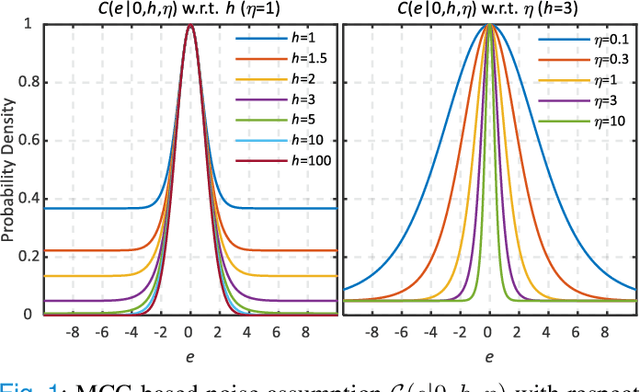
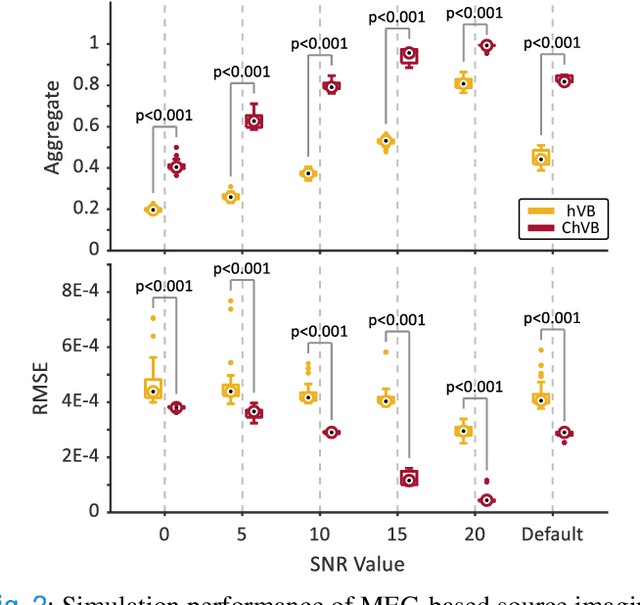
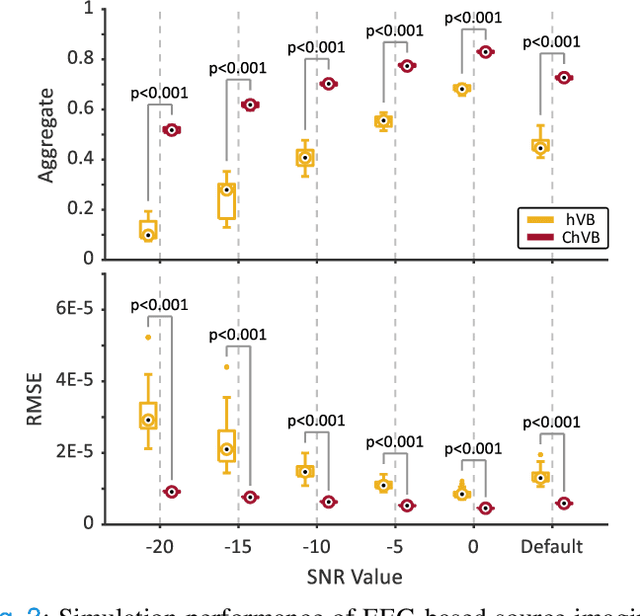
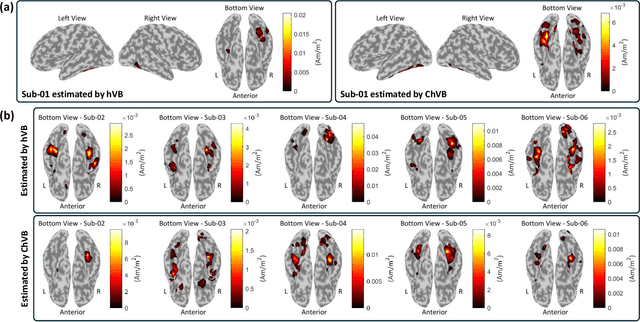
Abstract:Bayesian learning provides a unified skeleton to solve the electrophysiological source imaging task. From this perspective, existing source imaging algorithms utilize the Gaussian assumption for the observation noise to build the likelihood function for Bayesian inference. However, the electromagnetic measurements of brain activity are usually affected by miscellaneous artifacts, leading to a potentially non-Gaussian distribution for the observation noise. Hence the conventional Gaussian likelihood model is a suboptimal choice for the real-world source imaging task. In this study, we aim to solve this problem by proposing a new likelihood model which is robust with respect to non-Gaussian noises. Motivated by the robust maximum correntropy criterion, we propose a new improper distribution model concerning the noise assumption. This new noise distribution is leveraged to structure a robust likelihood function and integrated with hierarchical prior distributions to estimate source activities by variational inference. In particular, the score matching is adopted to determine the hyperparameters for the improper likelihood model. A comprehensive performance evaluation is performed to compare the proposed noise assumption to the conventional Gaussian model. Simulation results show that, the proposed method can realize more precise source reconstruction by designing known ground-truth. The real-world dataset also demonstrates the superiority of our new method with the visual perception task. This study provides a new backbone for Bayesian source imaging, which would facilitate its application using real-world noisy brain signal.
RSEA-MVGNN: Multi-View Graph Neural Network with Reliable Structural Enhancement and Aggregation
Aug 14, 2024Abstract:Graph Neural Networks (GNNs) have exhibited remarkable efficacy in learning from multi-view graph data. In the framework of multi-view graph neural networks, a critical challenge lies in effectively combining diverse views, where each view has distinct graph structure features (GSFs). Existing approaches to this challenge primarily focus on two aspects: 1) prioritizing the most important GSFs, 2) utilizing GNNs for feature aggregation. However, prioritizing the most important GSFs can lead to limited feature diversity, and existing GNN-based aggregation strategies equally treat each view without considering view quality. To address these issues, we propose a novel Multi-View Graph Neural Network with Reliable Structural Enhancement and Aggregation (RSEA-MVGNN). Firstly, we estimate view-specific uncertainty employing subjective logic. Based on this uncertainty, we design reliable structural enhancement by feature de-correlation algorithm. This approach enables each enhancement to focus on different GSFs, thereby achieving diverse feature representation in the enhanced structure. Secondly, the model learns view-specific beliefs and uncertainty as opinions, which are utilized to evaluate view quality. Based on these opinions, the model enables high-quality views to dominate GNN aggregation, thereby facilitating representation learning. Experimental results conducted on five real-world datasets demonstrate that RSEA-MVGNN outperforms several state-of-the-art GNN-based methods.
Relation DETR: Exploring Explicit Position Relation Prior for Object Detection
Jul 16, 2024Abstract:This paper presents a general scheme for enhancing the convergence and performance of DETR (DEtection TRansformer). We investigate the slow convergence problem in transformers from a new perspective, suggesting that it arises from the self-attention that introduces no structural bias over inputs. To address this issue, we explore incorporating position relation prior as attention bias to augment object detection, following the verification of its statistical significance using a proposed quantitative macroscopic correlation (MC) metric. Our approach, termed Relation-DETR, introduces an encoder to construct position relation embeddings for progressive attention refinement, which further extends the traditional streaming pipeline of DETR into a contrastive relation pipeline to address the conflicts between non-duplicate predictions and positive supervision. Extensive experiments on both generic and task-specific datasets demonstrate the effectiveness of our approach. Under the same configurations, Relation-DETR achieves a significant improvement (+2.0% AP compared to DINO), state-of-the-art performance (51.7% AP for 1x and 52.1% AP for 2x settings), and a remarkably faster convergence speed (over 40% AP with only 2 training epochs) than existing DETR detectors on COCO val2017. Moreover, the proposed relation encoder serves as a universal plug-in-and-play component, bringing clear improvements for theoretically any DETR-like methods. Furthermore, we introduce a class-agnostic detection dataset, SA-Det-100k. The experimental results on the dataset illustrate that the proposed explicit position relation achieves a clear improvement of 1.3% AP, highlighting its potential towards universal object detection. The code and dataset are available at https://github.com/xiuqhou/Relation-DETR.
Discovering Common Information in Multi-view Data
Jun 21, 2024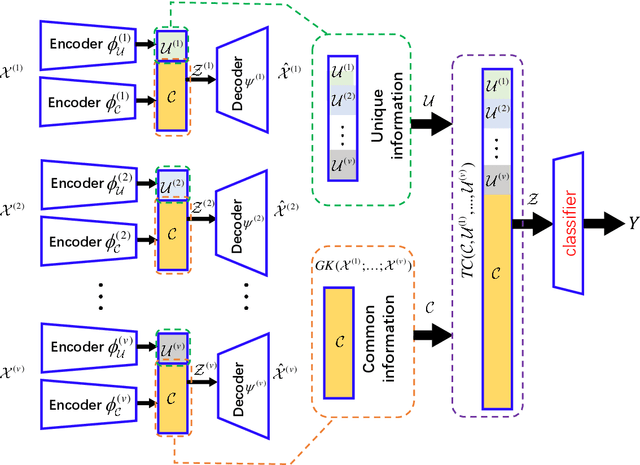
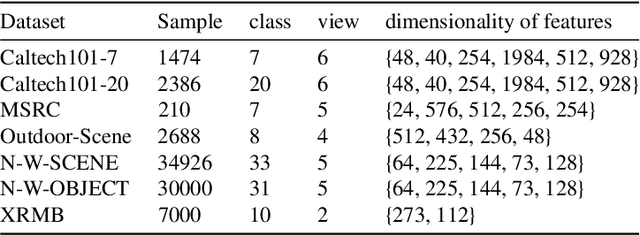
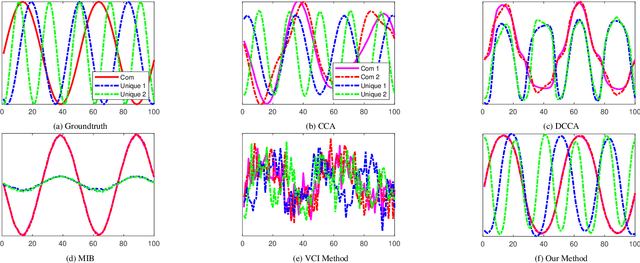
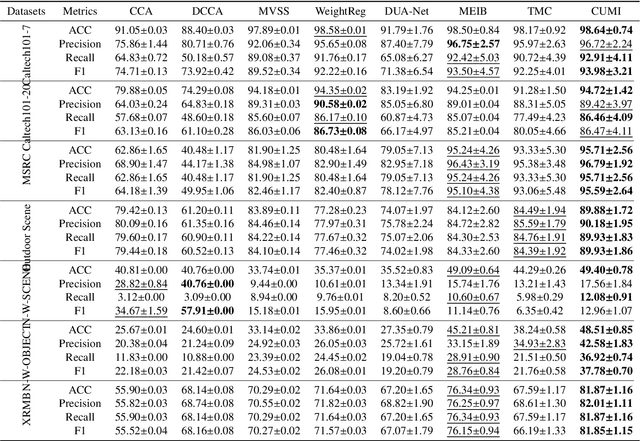
Abstract:We introduce an innovative and mathematically rigorous definition for computing common information from multi-view data, drawing inspiration from G\'acs-K\"orner common information in information theory. Leveraging this definition, we develop a novel supervised multi-view learning framework to capture both common and unique information. By explicitly minimizing a total correlation term, the extracted common information and the unique information from each view are forced to be independent of each other, which, in turn, theoretically guarantees the effectiveness of our framework. To estimate information-theoretic quantities, our framework employs matrix-based R{\'e}nyi's $\alpha$-order entropy functional, which forgoes the need for variational approximation and distributional estimation in high-dimensional space. Theoretical proof is provided that our framework can faithfully discover both common and unique information from multi-view data. Experiments on synthetic and seven benchmark real-world datasets demonstrate the superior performance of our proposed framework over state-of-the-art approaches.
 Add to Chrome
Add to Chrome Add to Firefox
Add to Firefox Add to Edge
Add to Edge